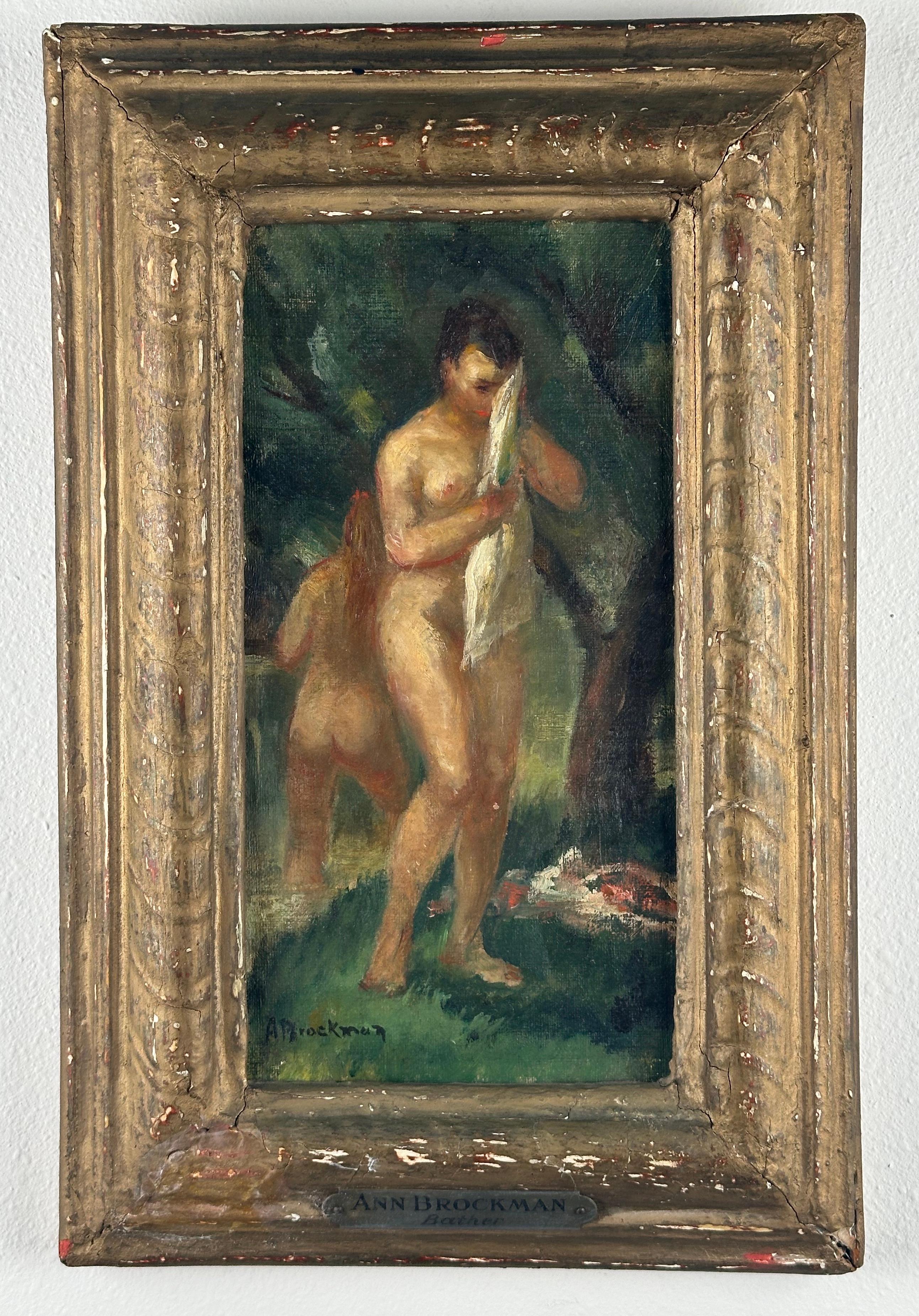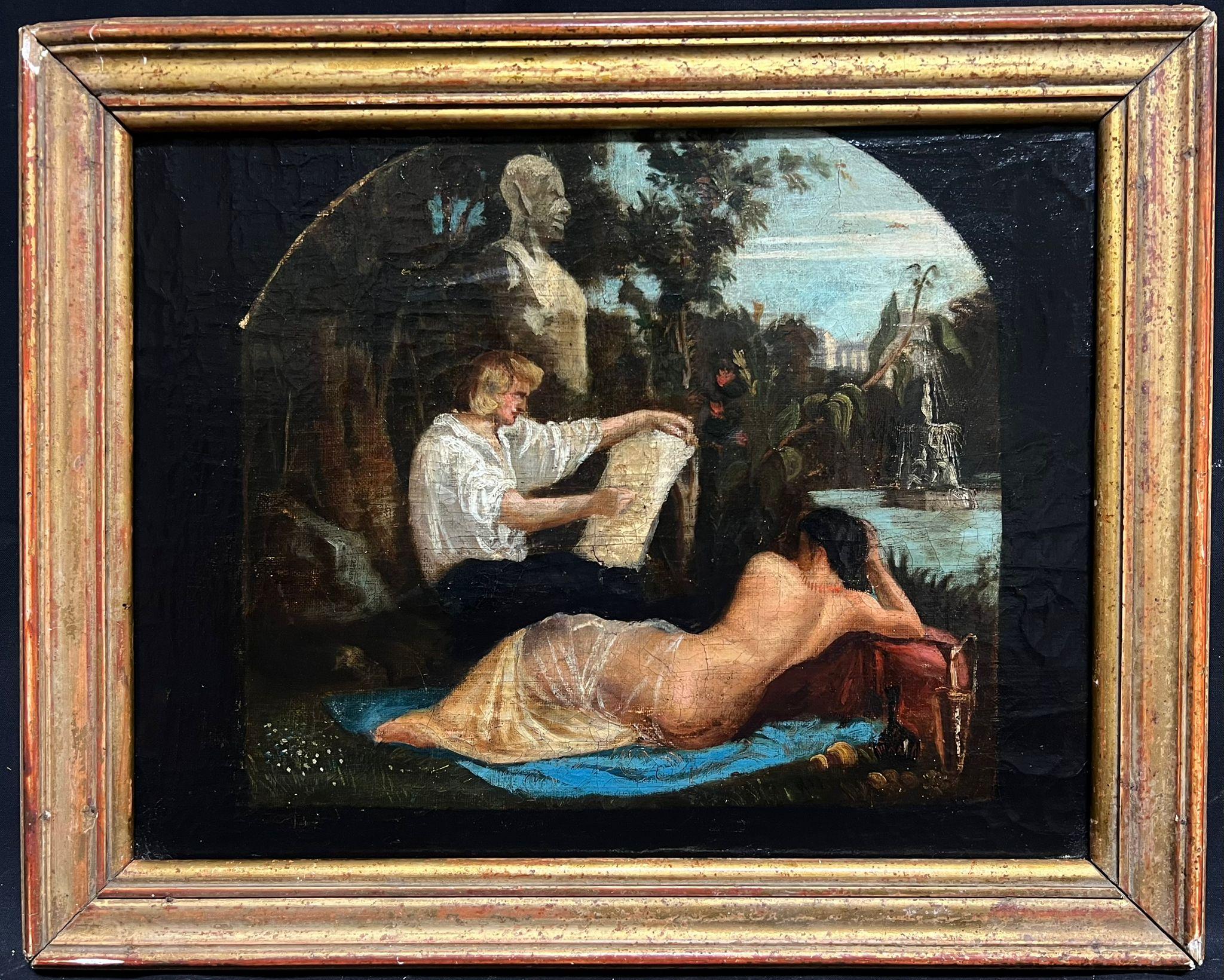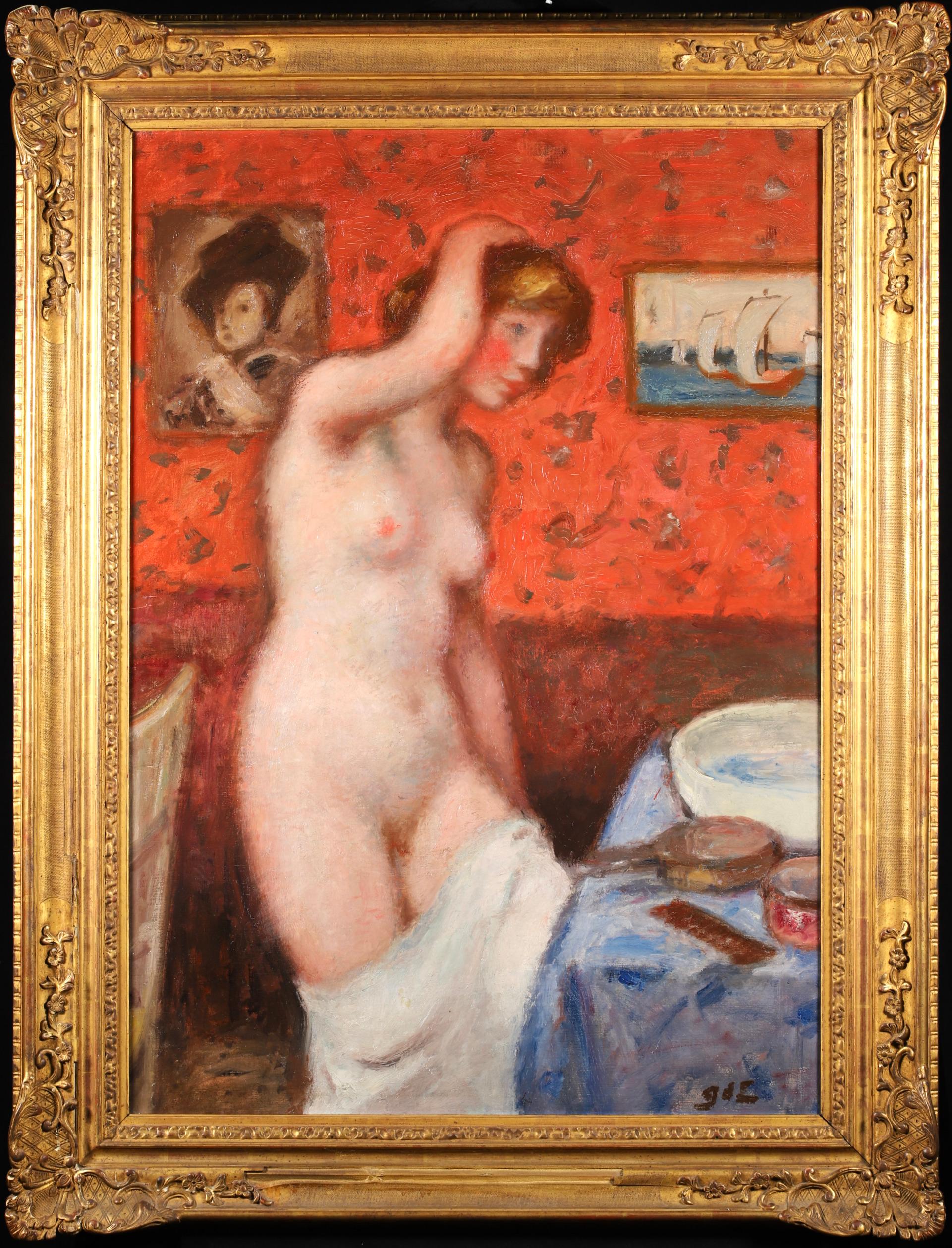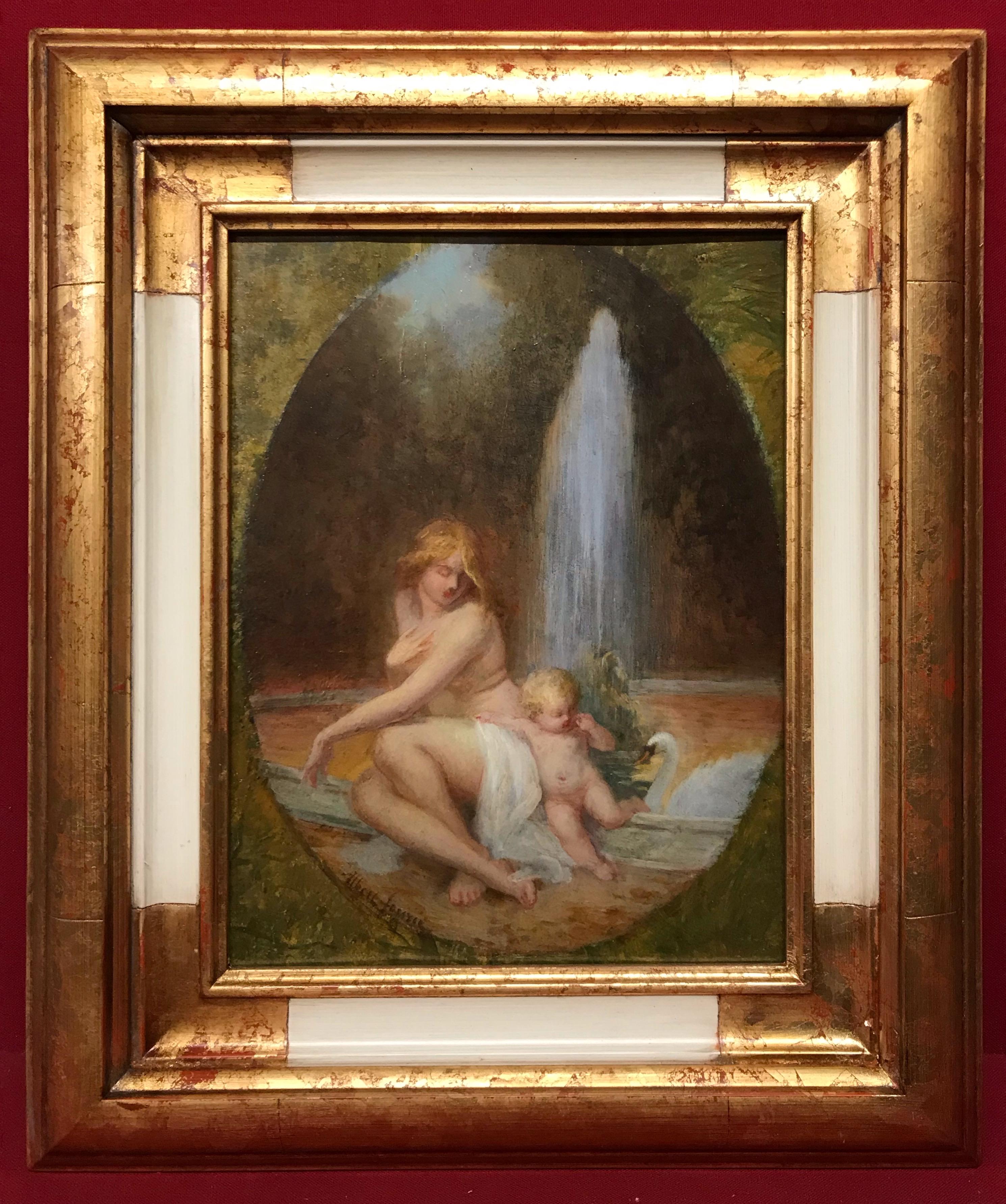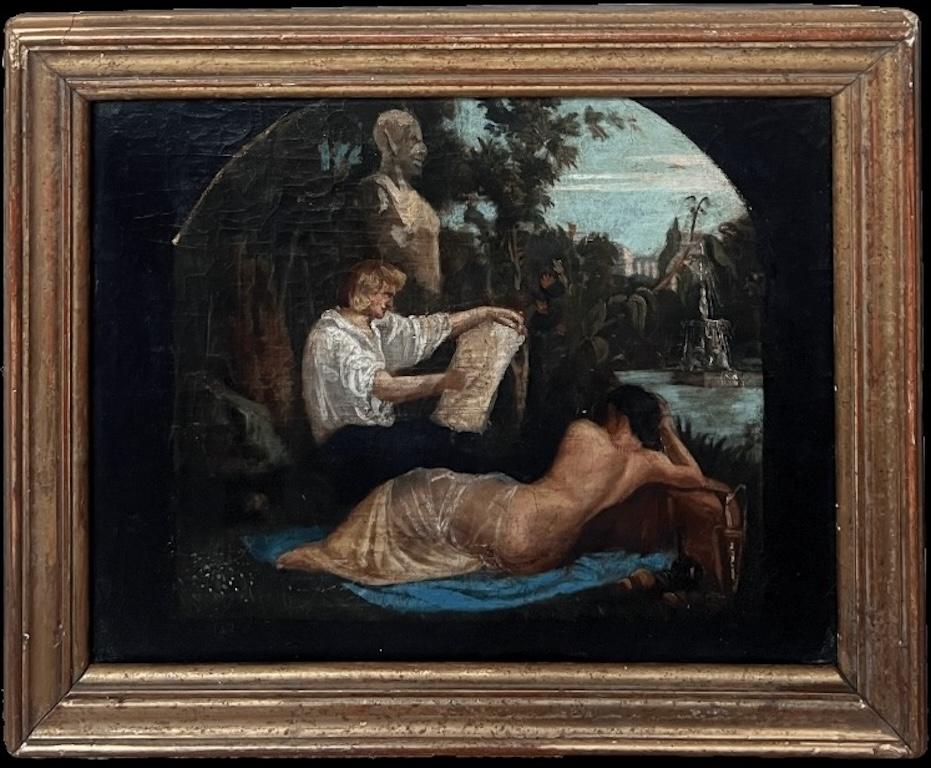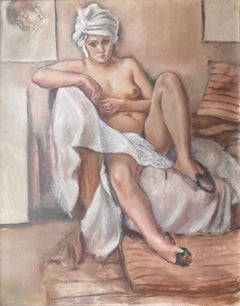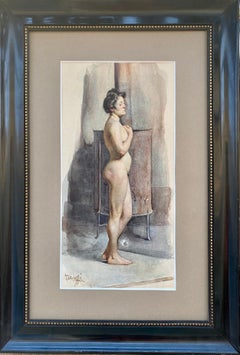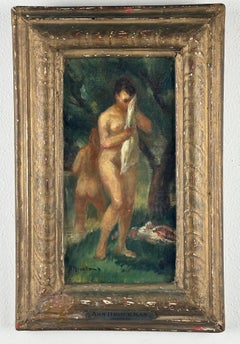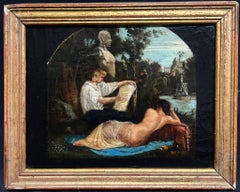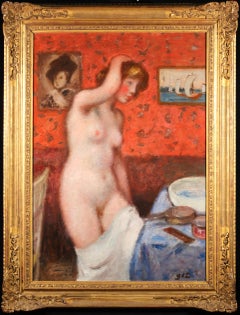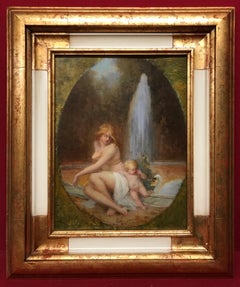Items Similar to The bather and the artist: the bashful nude naturalist French oil painting
Video Loading
Want more images or videos?
Request additional images or videos from the seller
1 of 10
Louis DauvergneThe bather and the artist: the bashful nude naturalist French oil paintingca 1885
ca 1885
$2,200
£1,682.02
€1,937.34
CA$3,082.87
A$3,441.74
CHF 1,803.42
MX$42,130.27
NOK 22,903.45
SEK 21,595.04
DKK 14,458.60
Shipping
Retrieving quote...The 1stDibs Promise:
Authenticity Guarantee,
Money-Back Guarantee,
24-Hour Cancellation
About the Item
It's just a little embarassing. Our young bather went for a skinny dip in the river and now needs to snatch her clothes without being spotted by the elderly artist on the river bank who is painting en plein air and is as yet blissfully unaware of her.
Fresh and with beautiful colours, this is a little gem of a painting.
The rare and interesting artist who painted it is Louis Dauvergne. A French provincial landowner's son, Louis spent two years in Rome as a young man, where he discovered a passion for painting. Upon his return to France, he stubbornly refused to take over the family farm as his father had hoped, and instead went to study painting in Paris.
He joined the studio of Thomas Couture , whom he frequented for many years, where he had Puvis de Chavannes as a fellow student and where he met Édouard Manet. Dauvergne exhibited at the Paris Salon from 1863.
With a private income, Louis painted for pleasure only.
With a tendency towards nonchalence and not particularly industrious, Louis probably didn't push himself as hard as he might have done. With more perseverance, he would easily have managed to occupy a great place in art, and would certainly have become a figure of reference.
Immensely talented, Dauvergne's painting is imbued with poetry, as as the present painting shows, he renders human skin with mastery.
Painted on a panel measuring 19 x 11 cm; our painting is signed by Dauvergne at the lower right. It is presented in its original frame.
- Creator:Louis Dauvergne (1828 - 1899, French)
- Creation Year:ca 1885
- Dimensions:Height: 14.57 in (37 cm)Width: 11.42 in (29 cm)Depth: 1.97 in (5 cm)
- Medium:
- Movement & Style:
- Period:
- Condition:bronze paint over the originally gilded frame.
- Gallery Location:Norwich, GB
- Reference Number:1stDibs: LU991315986752
About the Seller
5.0
Gold Seller
Premium sellers maintaining a 4.3+ rating and 24-hour response times
1stDibs seller since 2018
90 sales on 1stDibs
Typical response time: 1 hour
- ShippingRetrieving quote...Shipping from: Paris, France
- Return Policy
Authenticity Guarantee
In the unlikely event there’s an issue with an item’s authenticity, contact us within 1 year for a full refund. DetailsMoney-Back Guarantee
If your item is not as described, is damaged in transit, or does not arrive, contact us within 7 days for a full refund. Details24-Hour Cancellation
You have a 24-hour grace period in which to reconsider your purchase, with no questions asked.Vetted Professional Sellers
Our world-class sellers must adhere to strict standards for service and quality, maintaining the integrity of our listings.Price-Match Guarantee
If you find that a seller listed the same item for a lower price elsewhere, we’ll match it.Trusted Global Delivery
Our best-in-class carrier network provides specialized shipping options worldwide, including custom delivery.More From This Seller
View AllAuguste Renoir"s last student: impressionist female nude the Statuesque Bather
By Lucien Boulier
Located in Norwich, GB
If something about this painting seems familiar, it is for good reason! Dating from circa 1905-10, it is a work by Lucien Boulier (1882-1963), who was effectively Renoir's last stude...
Category
Early 20th Century Impressionist Figurative Paintings
Materials
Canvas, Oil
Paris Montparnasse, the Bohemian life, the artist's model resting female nude
Located in Norwich, GB
this painting perfectly encapsulates the artistic Parisian Montparnasse bohemianism of the 1920s and 30s. We see a beautiful but certainly nonchalent woman seated on a day bed in the...
Category
1930s Modern Figurative Paintings
Materials
Canvas, Oil
Italian Art nouveau Nude Boudoir painting woman warming herself by a stove Paris
By Tito Lessi
Located in Norwich, GB
A very pure and tender rendition of a female nude. Elegant in its simplicity, the artist's model, is warming herself by a large stove!
It is a work by Tito Lessi dating from circa 1890. Lessi was born in Florence, Italy and studied at the Florentine Academy of Fine Arts, under Enrico Pollastrini and Antonio Ciseri...
Category
1890s Academic Nude Drawings and Watercolors
Materials
Watercolor, Laid Paper
Boy in a landscape, large art deco period painting
Located in Norwich, GB
This luminous landscape is perfectly capturing the light of early spring. A boy is climbing over wooden farm gates, with a backdrop of rolling hills. The painting has a gloriously fr...
Category
1930s French School Landscape Paintings
Materials
Canvas, Oil
Children on the Beach Marine Landscape French Antique Oil Painting
Located in Norwich, GB
The setting is the French coast, on a tranquil summer's evening. Clouds are drawing in, the sky is turning dusky pink and purple, but there is still time left for play, for the children on the beach...
Category
Early 20th Century Academic Landscape Paintings
Materials
Canvas, Oil
Academic master drawing: Allegorical Scene artist in Musée d'Orsay
Located in Norwich, GB
A fascinating allegorical scene by French master Paul-Louis Delance (1848–1924), an artist known for the allegorical and history paintings. His grandfather was the Count Joseph van R...
Category
1870s Academic Figurative Drawings and Watercolors
Materials
Charcoal, Paper
You May Also Like
Female Bather (Nude Women)
Located in Wilton Manors, FL
Ann Brockman (1895–1943) was an American artist who achieved success as a figurative painter following a successful career as an illustrator. Born in California, she spent her childhood in the American Far West and, upon marrying the artist William C. McNulty, relocated to Manhattan at the age of 18 in 1914. She took classes at the Art Students League where her teachers included two realist artists of the Ashcan School, George Luks and John Sloan. Her career as an illustrator began in 1919 with cover art for four issues of a fiction monthly called Live Stories. She continued providing cover art and illustrations for popular magazines and books until 1930 when she transitioned from illustrator to professional artist. From that year until her death in 1943, she took part regularly in group and solo exhibitions, receiving a growing amount of critical recognition and praise. In 1939 she told an interviewer that making money as an illustrator was so easy that it "almost spoiled [her] chances of ever being an artist."[1] In reviewing a solo exhibition of her work in 1939, the artist and critic A.Z Kruse wrote: "She paints and composes with a thorough understanding of form and without the slightest hesitancy about anatomical structure. Add to this a magnificent sense of proportion, and impeccable feeling for color and an unmistakable knowledge of what it takes to balance the elements of good pictorial composition and you have a typical Ann Brockman canvas."[2]
Early life and training
Brockman was born in Northern California in 1895 and spent much of her youth in nearby Oregon, Washington, and Utah.[1][3] She met the artist William C. McNulty in Seattle where he was employed as an editorial cartoonist. They married in March 1914 and promptly moved to Manhattan where he worked as a freelance illustrator.[4][5] At the time of their marriage, Brockman was 18 years old.[6] Over the next few years, her career generally followed that path that her husband had previously taken. His art training had been at the Art Students League beginning in 1908; she began her training there after moving to New York in 1914.[1] After an early career as an editorial cartoonist, he freelanced as a magazine and book illustrator beginning in 1914; she began her career as a magazine and book illustrator in 1919.[7] He embarked on a teaching career in the early 1930s and not long after, she began giving art instruction.[8][9] While they both adhered to the realist tradition in art, their usual subjects were different. His prominently depicted urban cityscapes in the social realist whereas hers generally focused on rural landscapes. He was best known for his etchings and she for her oils and watercolors.[8][10]
Brockman returned to the Art Students League in 1926 to take individual instruction for a month at a time from George Luks and John Sloan.[1] Despite their help, one critic said McNulty's "sympathetic encouragement and guidance" was more important to her development as a professional artist.[11]
Career in art
In the course of her career as illustrator, Brockman would sometimes paint portraits of celebrities before drawing them, as for example in 1923 when she painted the French actress Andrée Lafayette who had traveled to New York to play title role in a film called Trilby.[12] She would also sometimes accept commissions to make portrait paintings and in 1929 painted two Scottish terriers on one such commission.[13] During this time, she also produced landscapes. In 1924 she displayed a New England village street scene painting in the Second Annual Exhibition of Paintings, Watercolors, and Drawings in the J. Wanamaker Gallery of Modern Decorative Art.[14] Available sources show no further exhibitions until in 1930 a critic for the Boston Globe described one of her portraits as "well done" in a review of a Rockport Art Association exhibition held that summer.[15]
Between 1931 and her death in 1943, Brockman participated in over thirty group exhibitions and five solos.[note 1] Her paintings appeared in shows of the artists' associations to which she belonged, including the Rockport Art Association, Salons of America, Society of Independent Artists, and National Association of Women Painters and Sculptors.[17][19]Between 1932 and 1935, her paintings appeared frequently in New York's Macbeth Gallery.[20][23][25][27] She won an award for a painting she showed at the Art Institute of Chicago in 1940.[41] In 1942, the Whitney Museum bought one of the paintings she showed in its Biennial of that year.[10] Critical praise for her work steadily increased during the decade that ended with her untimely death in 1943. In 1932, her painting called "The Camera Man" was called "a clever piece of illustration."[21] Three years later, a painting called "Small Town" gave a critic "the impression of freshness, honesty, and skill".[29] In 1938, a critic described her "Folly Cove" as "masterful" and said "Pigeon Hill Picnic" was "sustained by excellence of execution".[48] At that time, Howard Devree of the New York Times saw "evidence of gathering powers" in her work and wrote "she imparts a dramatic feeling to landscape. She even manages this time to do trees touched by Autumn tints without calendar effect, which is no small praise."[51] Three years later, a Times critic reported Brockman had "set herself a new high" in the watercolors she presented,[52] and another critic said the gallery where she was showing had not "for some time" shown "so outstanding a solo exhibitor as Ann Brockman."[2] Shortly before her death, a critic for Art News maintained that she was "one of America's most talented women painters".[46]
After she had died, a critic said Brockman's paintings "displayed real power", adding that she was "highly rated among the nation's professional artists" and was known to give "aid and encouragement, always with a smile," both artists and to her students.[10] in reviewing the memorial exhibition at the Kraushaar Galleries held in 1945, reviewers wrote about the strength and vibrancy of her personality, the quality of her painting ("every bit as good, possibly better than people had thought"),[53] called her "one of the best of our twentieth century women painters", and credited "her sense of the vividness of life" as a contributor to "the unusual breadth that is so characteristic of her work.[11] One noted that her work was "widely recognized throughout the country" and could be found in the collections of prominent museums, including the Metropolitan Museum of Art, the Whitney Museum of American Art, and the Art Institute of Chicago.[54] Writing in the Times, Devree wrote, "even those who had followed the steady growth of this artist for more than a decade, each successive show being at once an evidence of new achievement and an augury of still better work to come, may well be surprised at the combined impact of the selected paintings in the present showing,"[55] and writing in the Brooklyn Daily Eagle, A.Z Kruse said she had made "extraorginary accomplishments", painted with "inordinate distinction" showing a "lyrical majesty," and possessed "a keen esthetic sense which did not deviate from truth."[54]
Artistic style
(1) Ann Brockman, undated drawing, black chalk on paper, 18 x 22 inches
(2) Ann Brockman, High School Picnic, about 1935, oil on canvas, 34 1/4 x 44 1/4 inches
(3) Ann Brockman, untitled landscape, about 1943, watercolor and pencil on paper, 15 1/4 x 22 1/2 inches
(4) Ann Brockman, North Coast, undated watercolor, 21 1/2 x 30 inches
(5) Ann Brockman, On the Beach, 1942, watercolor on paper, 16 1/2 x 20 inches
(6) Ann Brockman, Lot's Wife, 1942, oil on canvas, 46 x 35 inches
(7) Ann Brockman, New York Harbor, 1934, watercolor on paper, 13 1/2 x 19 1/4 inches
(8) Ann Brockman, Youth, 1942, oil on board, 13 1/2 x 11 1/2 inches
Brockman was a figurative painter whose main subjects were rural landscapes and small-town and coastal scenes. She worked in oils and watercolors, becoming better known for the latter late in her career. Most of her paintings were relatively small. Although she made figure pieces infrequently, the nudes and circus and Biblical scenes she painted were seen to be among her best works. In 1938, Howard Devree wrote: "Her gray-day marines and coast scenes are familiar to gallery goers and are favorites with her fellow artists. Her figure pieces have attained a sculptural quality without losing warmth or taking on stiffness. One spirited circus incident of equestriennes about to enter the big tent compares not unfavorably with many of the similar pictures by a long line of painters who have been fascinated by the theme. She imparts a dramatic feeling to landscape. She even manages this time to do trees touched by Autumn tints without calendar effect, which is no small praise."[51] Similarly, a critic for Art Digest wrote that year: "Fluently and virilely painted, [her] canvases suggest a close affinity between nature and humans. The artist takes her subjects out in the open where they may picnic or bathe with space and air about them. A fast tempo is felt in the compositions of restless horses and nimble entertainers busily alert for the coming performance. Miss Brockman is also interested in portraying frightened groups of people, hurrying to safety or standing half-clad in the lowering storm light."[56]
Her palette ranged from vivid colors in bright sunlight to somber ones in the overcast skies of stormy weather. Of the former, one critic spoke of the rich colors and "sun-drenched rocks" of her coastal scenes and another of her "summery landscapes of coves and picnics."[11][50] Of the latter, Howard Devree said she "painted so many moody Maine coast vignettes of lowering skies and uneasy seas that artists have been heard to refer to an effect as 'an Ann Brockman day'".[57]
Brockman's handling of Biblical subjects can be seen in the oil called "Lot's Wife", shown above, Image No. 6. Her watercolor called "On the Beach" and her oil portrait called "Youth" may both indicate the "sculptural quality" that Devree said was typical of her figure pieces (Image No. 8, above).
An example of Brockman's bright palette in a typical summer theme is the oil painting called "High School Picnic" shown above, Image No. 2. Next to it is a painting, an untitled landscape of about 1943 whose medium, watercolor on paper, shows off the sunny palette she often used (Image No. 3).
Among the darkest of her works was an untitled 1942 drawing she made in black chalk (shown above, Image No. 1). In a book called Drawings by American Artists (1947), the artist and art editor Norman Kent noted that this study influenced her painting through its use of "forms" that were "elastic" and suggested "color". He said its "massing of dark and light" created "a definite mood" that was "impressionistic" and had "the strength of a man's work".[58] Brockman's undated watercolor called "North Coast" (shown above, Image No. 4) is an example of the paintings to which Kent referred.
Illustrator
(9) Ann Brockman, cover, March 12, 1917, Every Week magazine
(10) Illustration of an article, "The Taking of a Salient" by Henry Russell...
Category
1930s American Impressionist Nude Paintings
Materials
Oil
$1,200 Sale Price
20% Off
18th Century French Oil Artist Painting Nude Model Classical Garden Scene
Located in Cirencester, Gloucestershire
The Artist and his Model
French School, 18th century
oil on canvas, framed
Framed: 14 x 17 inches
Board: 11 x 14 inches
Provenance: private collection, France
Condition: very good co...
Category
18th Century Rococo Figurative Paintings
Materials
Oil
La Toilette - Post-Impressionist Nude Oil Painting by Georges D'Espagnat
By Georges d'Espagnat
Located in Marlow, Buckinghamshire
Signed oil on original canvas nude circa 1914 by French post impressionist painter Georges D'espagnat. The work depict a nude woman standing beside a wash basin in a boudoir.
Signature:
Signed lower right
Dimensions:
Framed: 45"x34"
Unframed: 37"x26"
Provenance:
Private collection - Netherlands
From the beginning of his career, it was a constant concern of Georges d'Espagnet to assert his originality. His studies at the École des Arts Décoratifs, Paris, did not last very long, for he wanted immediate independence and decided to follow courses in the private academies of Montparnasse. In about 1900, he became acquainted with Maurice Denis, Bonnard and Vuillard, and his collaboration with Denis led to a renewal of religious art in France.
In 1903, d'Espagnet was one of the founders of the Salon d'Automne, and was appointed professor in charge of studios at the École des Beaux-Arts, Paris, in 1934. He illustrated a number of books: Rémy de Gourmont's Evil Prayers ( Oraisons mauvaises) (1896), The Saints of Paradise ( Les Saintes du paradis) (1898), Simone (1907), Sistine ( Sixtine) (1922); Alphonse Daudet's The Immortal ( L'Immortel) (1930); André Gide's The Pastoral Symphony ( La Symphonie pastorale); Francis Jammes' Clearings in the Sky ( Chairières dans le ciel) (1948).
D'Espagnet belongs to the group of artists who made the Courrier Français so successful. The drawings of his which are published in it are strongly expressive and some bear comparison with the designs of the great Renaissance masters. He also contributed to L'Image. He often placed cheerful nudes in a landscape, reminding us that, though he moved away from the Fauves, he retained their freedom of colour and arabesque. He painted many portraits, including those of Albert André, André Barbier, Victor Boucher, Déodat de Séverac, Albert Marque, André Marty and Albert Roussel. He also painted mural decorations, including a wall for the Palais de la Découverte (1937), the ceiling of the Victor Hugo Room in the Palais du Luxembourg (1939), a decorative panel for the Palais de Justice, Toulouse (1941) and interior decorations for private houses. His landscapes are Impressionist in inspiration, and work for a certain sobriety, an intimacy, both in their composition - one, two or three sketched figures and large open spaces - and in the choice of colours and treatment with the special hazy brushstroke that marks his style.
D'Espagnet took part in a number of annual Parisian exhibitions, including the Salon des Indépendants, the Salon de la Société Nationale des Beaux-Arts, the Salon d'Automne (from 1903 to 1949, except in special circumstances), the Salon de la Libre Ésthétique, Brussels (1899, 1901), the Berlin Secessionists (1940). He also exhibited at the first Salon de la Société de la Gravure sur Bois. Among other exhibitions were 1912, A Century of French Art ( Centenaire de l'art français), St Petersburg; 1916, Kunstverein, Winterthur; 1918, 1926, Galerie M. Bertheim, Paris; 1930, Contemporary French Art...
Category
1910s Post-Impressionist Nude Paintings
Materials
Canvas, Oil
The Naiad and the Swan - Painting 19th Century
Located in Saint-Ouen, FR
Albert Auguste FOURIE (1854-1937)
The Naiad And The Swan
Oil on Wood signed low left
New golden and invory stick frame
Dim wood panel : 35 X 27 ...
Category
Late 19th Century Symbolist Nude Paintings
Materials
Oil
c. 1800's French Oil Artist Sketching Nude Model Classical Landscape Gardens
Located in Cirencester, Gloucestershire
The Artist at Work
French School, circa 1800's
oil on canvas,
framed: 13.5 x 17 inches
canvas: 11 x 14 inches
Provenance: private collection, France
Condition: very good condition
...
Category
Early 1800s French School Figurative Paintings
Materials
Oil
20th Century Oil on Canvas French Female Nude Painting Signed P. Sieffert, 1930
By Paul Sieffert
Located in Vicoforte, IT
Beautiful female nude painting from the first half of the 20th century. Oil on canvas, first canvas, artwork signed P. Sieffert, attributable to the French painter Paul Sieffert (the...
Category
1930s Nude Paintings
Materials
Canvas, Oil
More Ways To Browse
Young French Nude
Manet Original
French Academic Nudes
Vintage And Vogue Photography
Large Architectural Wall Art
Louvre Print
Plant Photography
Black White Photography Rolling Stones
Marilyn Monroe Beach
Vintage Italian Photographs
Japanese Art Plate
Vintage Books Photography
Vintage Actors Photos
Maeght Lithograph
18th Century Architectural Engravings
Antique Bourbon
1960s Pop Art
Lithograph Prints Of Architecture
